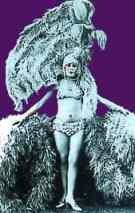
Style and Fashion
 Random Thoughts While Tossing and Turning: Whatever Happened to the Slip? Do They Expect Me to Wear a Thong? What About Modesty?
Random Thoughts While Tossing and Turning: Whatever Happened to the Slip? Do They Expect Me to Wear a Thong? What About Modesty?
Rose Madeline Mula writes: Why do high fashion models always look so angry? Is it because they’re in agony teetering on those ridiculous six-inch stilettoes — or because they’re forced to wear ugly outfits like flouncy dresses with unlaced combat boots and plaid skirts with flowered shirts. One ad featured a model in profile, wearing a nondescript dress, striding purposefully ahead. Her arm hung by her side, and from her hand a smallish pocketbook, which she held by a long strap, dangled almost at street level. Flames were shooting from the pocketbook, which didn’t seem to concern her a bit. more »
 FDA: Warning Letters Address Drug Claims Made for Products Marketed as Cosmetics; Senators Feinstein and Collins Persist In Pursuing One Product's Effects
FDA: Warning Letters Address Drug Claims Made for Products Marketed as Cosmetics; Senators Feinstein and Collins Persist In Pursuing One Product's Effects
"Under the Federal Food, Drugs and Cosmetic Act (FD&C Act), a product intended to diagnose, mitigate, treat, or prevent disease, or to affect the structure or function of the body is classified as a drug. If such a product is not generally recognized by qualified experts as safe and effective when used as labeled, it is a “new drug” and requires an approved New Drug Application to be marketed legally in the United States. FDA issued Warning Letters, citing drug claims associated with topical skin care, hair care, and eyelash/eyebrow preparations, noted on both product labeling and Web sites. Some examples of the drug claims cited are acne treatment, cellulite reduction, stretch mark reduction, wrinkle removal, dandruff treatment, hair restoration, and eyelash growth." more »
 100 Pairs of Shoes: Walk This Way Exhibition Includes Stories of Conformity, Independence, Culture, Class, Politics and Performance
100 Pairs of Shoes: Walk This Way Exhibition Includes Stories of Conformity, Independence, Culture, Class, Politics and Performance
In the early 1900s, when women made up less than 20 percent of the total industrial workforce, one-third of the workers in shoe factories were women. Women became active in trade unions like the Daughters of St. Crispin, named after the patron saint of shoemakers, and the International Boot & Shoe Workers Union, participating in strikes to protest low wages and poor treatment. Considered radical for its time, by 1904 the Boot & Shoe Workers Union constitution called for “uniform wages for the same class of work, regardless of sex.” An intricately beaded shoe (c. 1915), stamped with the union seal, shows off the quality of American shoemaking. more »
 Art Nouveau In the Netherlands, a Quest for the 'Truth', the 'Genuine', the Original; Leaving in Architecture and the Decorative Arts
Art Nouveau In the Netherlands, a Quest for the 'Truth', the 'Genuine', the Original; Leaving in Architecture and the Decorative Arts
A new art for a new, improved society. That is what many artists and designers were looking for around 1900. After a century of styles that literally quoted the past, new forms language emerged, based on asymmetry, curved lines and organic decorative motifs. The Netherlands played its own unique role in this artistic quest. The Gemeentemuseum is showcasing the finest decorative arts in a broad context, making the dynamics of the age (1884-1914) visible, tangible and recognizable in this age where authenticity and craftsmanship are once more highly prized. more »






